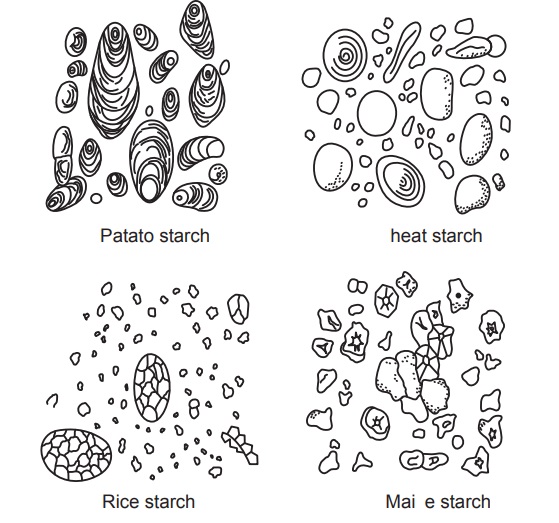Starch
| Home | | Pharmacognosy |Chapter: Pharmacognosy and Phytochemistry : Drugs Containing Carbohydrates and Derived Products
Starch consists of polysaccharide granules obtained from the grains of maize (Zea mays Linn.); rice (Oryza sativa Linn.); or wheat (Triticum aestivum Linn.); belonging to family Gramineae or from the tubers of potato (Solanum tuberosum Linn.), family Solanaceae.
STARCH
Synonyms
Amylum.
Biological Source
Starch consists of polysaccharide granules obtained from the
grains of maize (Zea mays Linn.);
rice (Oryza sativa Linn.); or wheat (Triticum aestivum Linn.); belonging to
family Gramineae or from the tubers of potato (Solanum tuberosum Linn.),
family Solanaceae.
Geographical Source
Most of tropical, as well as, sub-tropical countries prepare
starch commercially.
Preparation of Starch
Depending upon the raw material to be used for processing or
type of the starch to be produced, different processes are used for the
commercial manufacture of starch.
Potato Starch: The potatoes are washed to remove
the earthy
matter. They are crushed or cut and converted into slurry. Slurry is filtered
to remove the cellular matter. As potatoes do not contain gluten, they are very
easy to process further. After filtration, the milky slurry containing starch
is purified by centrifugation and washing. Then, it is dried and sent to the
market.
Rice Starch: The broken pieces of rice resulted during the polishing are used for
processing. The pieces of rice are soaked in water with dilute sodium hydroxide
solution (0.5%), which causes softening and dissolution of the gluten. After
this, the soaked rice pieces are crushed and starch prepared as described under
potato starch.
Maize Starch (corn starch): Maize grains are washed thoroughly with water to remove the
adhered organic matter after which they are softened by keeping in warm water
for 2–3 days. Sufficient sulphur dioxide is passed to the medium to prevent
fermentation. The swollen kernels are passed through attrition mill to break the
grains, so as to separate the endosperm and outermost coating of the grains. At
this point, special attention is given to separate the germ (embryo). This is
effected by addition of water, wherein germs float and are separated. The water
which is used to soften the grains dissolves most of the minerals, soluble
proteins and carbohydrates from the grains. The water, being rich in all these
contents, is used as a culture medium for the production of antibiotics like
penicillin (corn steep liquor). The separated germs are used to prepare the
germ oil by expression method and are known as corn oil. The oil contains fatty
acids like linoleic and linolenic acids and vitamin E. It is used commercially,
for the prepa-ration of soap. The starchy material contains gluten; most of
this is removed by simple sieving and then by washing. Starch being heavier,
settles at the bottom and is followed by gluten. Several treatments with cold
water wash the starch effectively, which is then centrifuged or filter-pressed
and finally, dried in flash dryers on a moving belt dryer.
Wheat Starch: Wheat being the major article of food is restrictedly used for preparation of
starch. In this process, the wheat flour is converted into dough and kept
for-a-while. The gluten in the dough swells and the masses are taken to grooved
rollers, wherein water is poured over them with constant shaking. The starchy
liquid coming out of the rollers is processed conveniently to take out the
starch, which is then dried and packed suitably.
Description

Microscopic Characters
Rice Starch: The granules are simple or compound. Simple granules are polyhedral, 2–12 μ in diameter. Compound granules are ovoid and 12–30 μ × 7 to 12 μ in size. They may contain 2–150
components.
Wheat Starch: Simple lenticular granules which are cir-cular or oval in
shape and 5–50 μ in diameter. Granules contain hilum
at the centre and concentric faintly marked striations. Rarely, compound
granules with two to four components are also observed.
Maize Starch: Granules are polyhedral or rounded, 5–31 in diameter, with distinct cavity in
the centre or two to five rays cleft.
Potato Starch: Generally, found in the form of
simple granules,
which are sub-spherical, somewhat flattened irregularly ovoid in shape. Their
sizes vary from 30–100 μ. Hilum is present near the narrower
end with well-marked concentric striations.

Chemical Constituents
Starch contains chemically two different polysaccharides,
such as amylose (β-amylose) and amylopectin (α-amylose), in the proportion of 1:2. Amylose is water
soluble and amylopectin is water insoluble, but swells in water and is
responsible for the gelatinizing property of the starch. Amylose gives blue
colour with iodine, while amylopectin yields bluish black colouration.
Identification Tests
1. Boil 1 g of starch with 15 ml of
water and cool. The translucent viscous jelly is produced.
2. The above jelly turns deep blue by
the addition of solution of iodine. The blue colour disappears on warming and
reappears on cooling.
Uses
Starch is used as a nutritive, demulcent, protective and as
an absorbent. Starch is used in the preparation of dusting talcum powder for
application over the skin. It is used as antidote in iodine poisoning, as a
disintegrating agent in pills and tablets, and as diluent in dry extracts of
crude drug. It is a diagnostic aid in the identification of crude drugs.
Glycerin of starch is used as an emollient and as a base for suppositories.
Starch is also a starting material for the commercial manufacture of liquid
glucose, dextrose and dextrin. Starch is industrially used for the sizing of
paper and cloth.
Substitutes and Adulterants
Tapioca starch or Cassava or Brazilian arrowroot- This
starch is obtained from Manihot esculenta
(Euphorbiaceae) and is used as substitute for starch.
